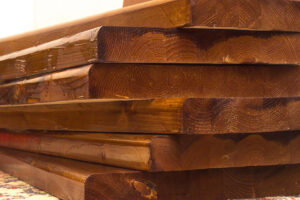
Among the innumerable varieties of wood that exist, there are some that reach unique and sought-after performance peaks, both in terms of functionality and robustness, as well as aesthetic appearance: we are of course talking about the so-called precious woods, which, although they are divided into different types that we will analyse in the following paragraphs, all have the same common denominator, superb quality.
This undoubtedly stems from the natural characteristics of the trees from which the timber in question is obtained, but there is one factor that cannot be overlooked: even the most valuable wood, in the state in which it is found in nature, cannot be used for man-made purposes, because it contains excessive amounts of water and high moisture content. So, also in this respect, the drying process is decisive: without the removal of the watery content inside them, the various types of precious wood would not be able to realise their unquestionable qualities definitively.
From ebony to mahogany, discovering precious woods
Before analysing the drying of precious woods in more detail, we need to understand exactly what they are. The species are numerous, so we list below the best known ones, the ones you are most likely to come across:
- Chestnut. This wood, distinguishable by its white, yellowish sapwood (part of the tree just below the bark) and light brown heartwood (inner part), is distinguished by its extreme strength and versatility (it can be used in the most diverse areas: furniture, roofs, parquet, window frames, kitchen utensils, etc.), characteristics that are common to all its variants (European, American and Japanese, depending on origin);
- Walnut. Widespread in various parts of the world in hilly and low-mountainous areas, this is a wood that combines the yellowish hues of the sapwood and the greyish hues of the heartwood with irregular smoke-coloured veins. It has good mechanical strength, is very sensitive to moisture and is especially popular in the luxury furniture sector. Its most valuable species is the European walnut, which precedes the American walnut and the Brazilian walnut;
- Oak. The typical brown hues of this wood vary depending on its geographical origin (American, European or Japanese), but in any case , it always features ductility, flexibility, longevity and porosity. Oak planks are ideal for building applications, while in terms of furniture, they are an excellent solution for parquet;
- Mahogany. Let us now move on to the purest exoticism: mahogany is a tropical tree from Central America, from which a wood of first-class hardness and firmness is obtained. It is very heavy and durable, it enjoys good stability and aesthetically it stands out for the unmistakable visual impact it offers: after all, the shades that colour it range from yellow to dark brown, passing through reddish. It is mainly used in the fine furniture sector, where it competes with walnut;
- Ebony. The refined elegance of black colour is known the world over. It is the unique colouring of this highly valuable wood, found in the forests of India, East Africa and Indonesia, that has made it famous. But the peculiarities of ebony do not end there: good stability and durability, hardness and compactness, low deformability and resistance to bending and twisting are other qualities that make it a renowned solution. To do what? Luxury furniture, small sculptures, knife handles, musical instruments and generally ornamental objects: ebony, due to its density, is perfect for carving!
The delicate treatment of exotic timber
In the case of exotic wood, the drying process acquires, if possible, an even more significant value than for ordinary wood, because not only does the refinement of its performance characteristics depend on it, but also one of the main factors that induces people to choose fine wood: aesthetics. On the other hand, if drying is not carefully managed, there is the risk of causing obvious cracks in the material, which can spoil the grain of the wood: within certain limits, this is not a problem from a structural point of view, while it is always a significant consequence from an aesthetic point of view.
Complicating the situation is also the fact that dealing with exotic timber, in view of its unique properties, requires special care. Example par excellence, in this respect, is ebony. Normally it has a rather low moisture content inside, so it has to be dried at varying rates, from moderate to low. But the slowness of the process is one of those factors that can cause serious cracks. Only scrupulous and well-conducted drying at every stage can prevent problems: and this is precisely what Incomac systems achieve. They allow precise management of every decisive element of the process, from air circulation to temperature control, at any time, and in fact they are all suitable for the treatment of exotic and precious timber.
The advantages of quality artificial drying
Even on the precious timber side, the classic advantages of artificial drying remain:
- In terms of timescale, it is a much faster process than natural drying;
- It eliminates any fungi or insects embedded in the wood, while also protecting against possible future attacks by wood-decay organisms;
- It reduces the weight of the wood, resulting in lower transport costs;
- It lays the foundations for subsequent painting or finishing of wood;
- It increases the mechanical strength and durability of the material.
